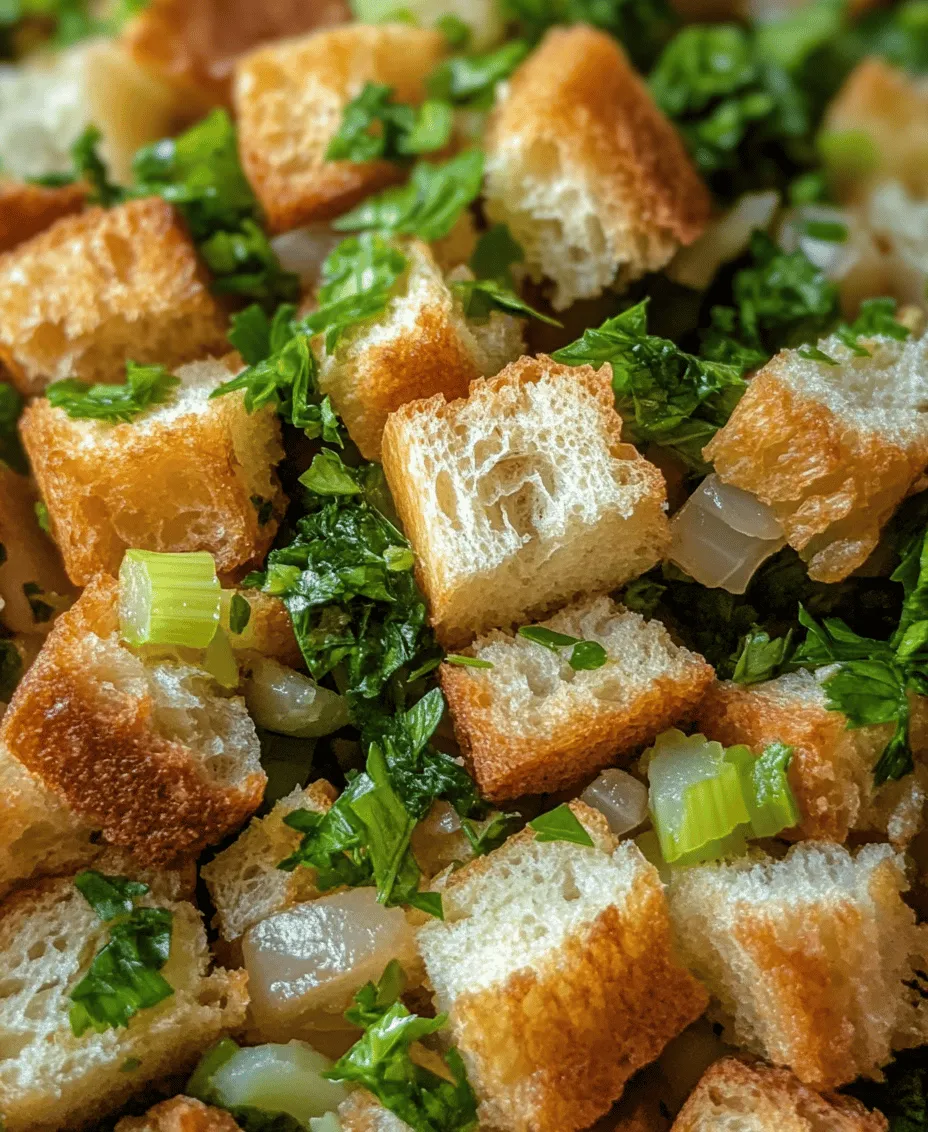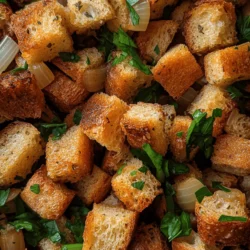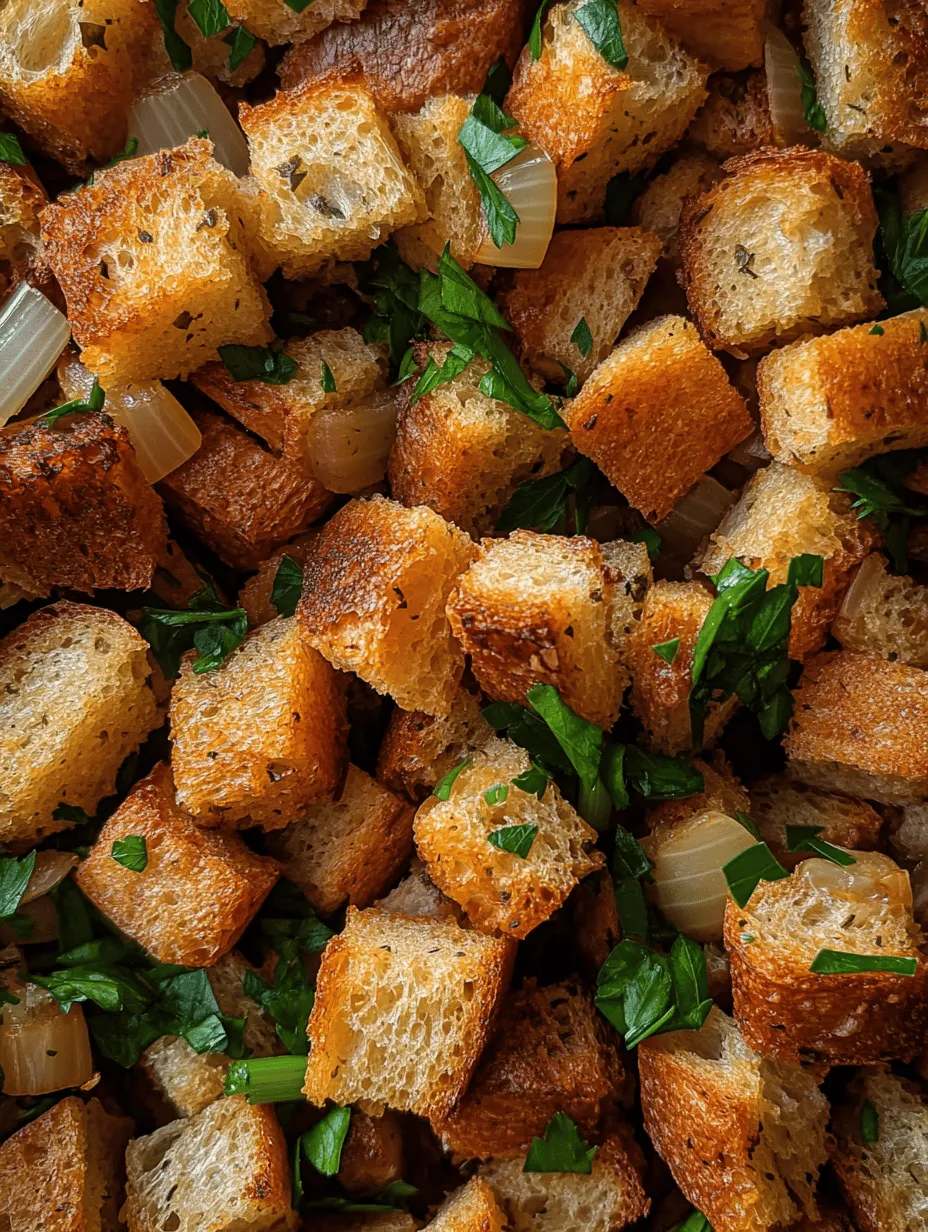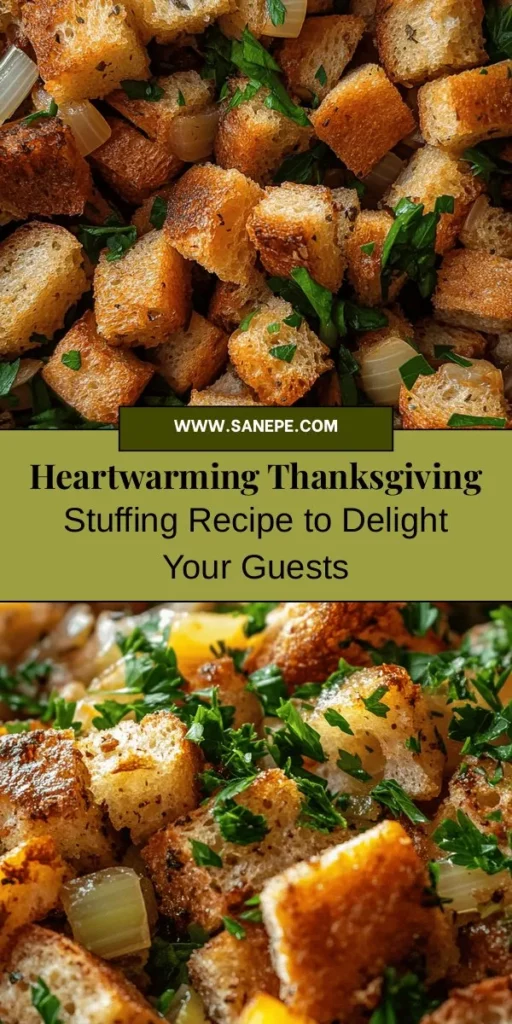Introduction
Thanksgiving is a cherished holiday in American culture, a time for families and friends to gather around the table and express gratitude for the blessings in their lives. At the heart of this celebration lies a spread of traditional dishes that evoke nostalgia and warmth, with one dish standing out: stuffing. For many, the aroma of stuffing baking in the oven is synonymous with Thanksgiving, representing comfort, togetherness, and the joy of sharing a meal.
Stuffing, often referred to as dressing in some regions, plays a pivotal role during the Thanksgiving feast. This dish not only complements the turkey but also elevates the overall dining experience with its rich flavors and hearty textures. The magic of a well-prepared stuffing lies in its ability to absorb the flavors of the herbs and spices, as well as the drippings from the turkey, creating a mouthwatering dish that keeps everyone coming back for seconds.
What makes this traditional Thanksgiving stuffing recipe special is its heartwarming flavors and comforting textures. Combining rustic bread with fresh vegetables and a medley of herbs, this stuffing is sure to remind you of family gatherings, holiday cheer, and the essence of gratitude. Let’s explore the basics of Thanksgiving stuffing, its historical context, and dive into the essential ingredients that make this recipe a must-try for your holiday celebrations.
Understanding the Basics of Thanksgiving Stuffing
Before we delve into the preparation of our heartwarming stuffing, it’s important to clarify the distinction between stuffing and dressing. Stuffing is typically cooked inside the turkey, allowing it to absorb the flavors of the meat and drippings, whereas dressing is prepared separately, usually baked in a casserole dish. Regardless of terminology, both versions share the same goal: to provide a flavorful, complementary side dish that enhances the main course.
Historically, stuffing has roots that date back centuries, with variations found in many cultures around the world. Early American settlers adapted European traditions, bringing their own regional flavors and ingredients to the table. Over time, stuffing has evolved, incorporating local produce and spices, resulting in an array of unique recipes that reflect family heritage and cultural influences.
Common ingredients in stuffing include bread, vegetables, broth, herbs, and spices. Some families have their own treasured twist, whether it’s the addition of sausage, nuts, or dried fruits. This diversity is what makes stuffing a personal and meaningful dish, as each recipe tells a story and holds memories of shared meals and family traditions.
Essential Ingredients for the Perfect Stuffing
To create a stuffing that is bursting with flavor and has the perfect texture, we must carefully select our ingredients. This traditional Thanksgiving stuffing recipe features a blend of mainstays that contribute to its heartwarming essence.
Rustic Bread: The foundation of any good stuffing is bread. For this recipe, we recommend using a rustic loaf, such as sourdough or a hearty country bread. The texture of these breads provides a satisfying chewiness that soaks up the broth beautifully. Day-old bread works best, as it is drier and will hold its shape when combined with other ingredients.
Fresh Vegetables: A classic stuffing recipe often includes a mix of sautéed onions, celery, and garlic. These vegetables add depth and sweetness, creating a well-rounded flavor profile. Sautéing them enhances their natural sugars, imparting a rich taste that permeates the entire dish.
Herbs and Spices: The secret to a flavorful stuffing lies in the herbs and spices. Fresh or dried thyme, sage, and rosemary are traditional choices that evoke the essence of Thanksgiving. A pinch of salt and freshly ground black pepper rounds out the seasoning, ensuring every bite bursts with flavor.
Broth and Eggs: To achieve the ideal moisture level and binding, broth (chicken or vegetable) and eggs are essential. The broth infuses the stuffing with additional flavor, while the eggs help bind the ingredients together, giving the stuffing a cohesive texture.
Optional Add-Ins: For those looking to elevate their stuffing even further, consider adding sausage for a savory kick or diced apples and dried cranberries for a touch of sweetness. These optional ingredients can personalize your stuffing, making it a unique centerpiece of your Thanksgiving meal.
Step-by-Step Preparation of Thanksgiving Stuffing
With our essential ingredients in hand, it’s time to begin the preparation of our heartwarming Thanksgiving stuffing. Below, we’ll outline the first steps to ensure that your stuffing turns out perfectly.
Preparing the Bread
The first step in making stuffing is preparing the bread. It’s important to toast and dry the bread to ensure it can absorb the flavors of the broth and other ingredients without becoming soggy. Start by cutting the rustic bread into bite-sized cubes. Spread the cubes evenly on a baking sheet and toast them in a preheated oven at 300°F (150°C) for about 15-20 minutes, or until they are golden and dry. This process enhances the bread’s flavor while providing the necessary texture for the stuffing.
Sautéing the Vegetables
Next, we move on to the vegetables. In a large skillet, heat a few tablespoons of butter or olive oil over medium heat. Add finely diced onions, chopped celery, and minced garlic to the skillet. Sauté the vegetables for around 5-7 minutes, stirring occasionally, until they become soft and translucent. This step is crucial, as it builds the flavor base for the stuffing. You want to ensure that the onions are fragrant and the celery has softened, releasing their natural sweetness.
Once the vegetables are sautéed to perfection, it’s time to assemble the stuffing. In a large mixing bowl, combine the toasted bread cubes with the sautéed vegetable mixture. Sprinkle in the herbs and spices, ensuring an even distribution throughout the bread. Next, pour in the broth, starting with a cup, and gently fold the ingredients together. The goal is to moisten the bread without making it overly soggy, so add more broth as needed until the bread is just moist enough to hold together.
As we continue with the preparation of this heartwarming traditional Thanksgiving stuffing recipe, we will explore how to complete the assembly and baking process, ensuring that your dish emerges from the oven golden, fragrant, and ready to delight your holiday guests.

Seasoning the Mixture: Tips for Balancing Flavors with Herbs and Spices
The key to a memorable Thanksgiving stuffing lies significantly in the seasoning. A well-seasoned stuffing elevates the dish, providing depth and complexity that complements the turkey and other sides. Start by using a mixture of fresh and dried herbs to enhance flavor. Common choices include sage, thyme, and rosemary, which evoke the essence of the season.
For a balanced flavor profile, consider the following tips:
1. Fresh Herbs vs. Dried Herbs: Fresh herbs are fragrant and vibrant, while dried herbs have a more concentrated flavor. A good rule of thumb is to use three times as much fresh herbs as dried. If you’re using dried herbs, add them earlier in the cooking process to allow their flavors to bloom.
2. Layering Flavors: Incorporate herbs and spices at different stages of cooking. Sauté some with the onions and celery to build a flavor base, and reserve a little to sprinkle in during the final mixing for a fresh burst of aroma.
3. Taste as You Go: As you combine your ingredients, taste the mixture to ensure the seasoning is balanced. Adjust as needed, keeping in mind that the stuffing will absorb flavors from the broth and the turkey itself.
Combining Ingredients: Ensuring Even Distribution of Flavors and Textures
Once your base is sautéed and perfectly seasoned, it’s time to combine the ingredients. For a stuffing that’s rich in flavor and varied in texture, follow these guidelines:
1. Bread Variety: Use a combination of bread types—such as sourdough, white bread, or whole grain. Each type contributes its unique texture and flavor, creating a more interesting stuffing.
2. Even Distribution: When mixing your bread with the sautéed vegetable and herb mixture, break the bread into uniform pieces to ensure even absorption of the broth. This will help achieve the perfect consistency throughout.
3. Gentle Folding: Use a spatula to gently fold the mixture, ensuring you don’t create a mushy texture. The goal is to have a cohesive mixture where each piece of bread maintains its structure while soaking up flavors.
Properly Moistening the Stuffing: Avoiding Sogginess While Ensuring Flavor
Achieving the right moisture level in your stuffing is crucial. Too much liquid can lead to a soggy stuffing, while too little can result in a dry, crumbly texture. To find that sweet spot, consider these tips:
1. Broth Application: Gradually add your broth to the mixture, stirring as you go. This allows you to gauge the moisture level without overwhelming the stuffing. Aim for a consistency that feels moist but not mushy.
2. Eggs for Binding: Incorporating beaten eggs into the mixture not only helps bind the ingredients but also adds richness and moisture. This is particularly important when using drier bread varieties.
3. Resting Time: Allow the stuffing to rest for about 15-20 minutes before baking. This resting period helps the bread absorb the broth and flavors, leading to a more cohesive stuffing.
Baking the Stuffing to Perfection
The baking process is where your stuffing transforms into a beautifully golden and aromatic dish. Proper temperature control and technique are essential for achieving that perfect crust and flavor.
Importance of Temperature Control in Baking
Baking your stuffing at the correct temperature is vital. Preheat your oven to 350°F (175°C). This temperature allows the stuffing to cook evenly, developing a nice crust on top while ensuring the inside remains moist.
Covering vs. Uncovering During the Baking Process: Achieving the Perfect Crust
During baking, the decision to cover the stuffing or not can significantly affect the final texture:
1. Covering: Initially covering the stuffing with aluminum foil for the first half of the baking time helps retain moisture and heat. This prevents the top from browning too quickly while allowing the stuffing to cook through.
2. Uncovering: For the last 20-30 minutes, remove the foil to allow the top to crisp up and develop a golden brown crust. This contrast between the soft interior and crunchy exterior is what makes stuffing so delightful.


